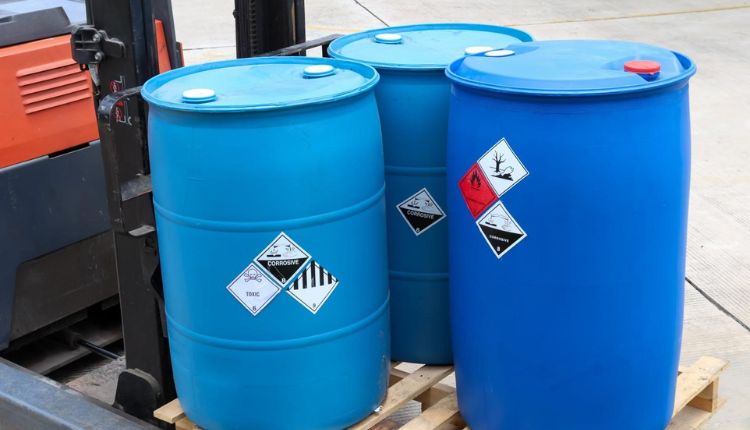Various job tasks across industries require employees to handle or work with hazardous materials or toxic chemicals. Often, employees are indirectly exposed to such hazards due to the type of work they do. For instance, housekeeping and cleaning jobs require personnel to utilize chemicals for cleaning, polishing, and maintaining the interiors and exteriors of buildings.
People doing repair and maintenance work in buildings constructed pre-mid-1970s may involuntarily be exposed to asbestos due to the widespread use of asbestos-containing materials (ACM) during that period.
| Examples of Hazardous Materials:
Hydrogen Sulfide Asbestos Lead Silica Chemicals Hazardous Waste |
During construction work, laborers employed to clean and maintain debris-free worksites may need to use special chemicals and cleaning compounds that may hurt the human body. Additionally, work in construction sites also exposes cleaning crews to pre-existing hazards such as inhalation of toxic dust, fumes from paintwork, or myriad other types of hazards. Other types of professionals such as electricians, inspectors, supervisors, architects, etc., may also be indirectly exposed to the hazards caused by hazardous chemicals and materials used at specific worksites.
Due to the widespread use of chemicals and other hazardous materials in manufacturing operations and our everyday lives, personnel employed across industries and occupations could be at risk of occupational exposure to hazardous materials and other chemicals.
Furthermore, personnel employed in hazardous waste operations, whether they collect, sort, recycle, treat, transport, dispose of, or monitor waste disposal sites are equally in danger of exposure to hazardous materials and other toxic substances, thereby increasing the risks to personal health and safety. According to the U.S. Bureau of Labor Statistics (BLS), 672 worker fatalities were recorded in 2020 (the highest since this data series began in 2011) due to exposure to harmful substances or environments.
The various examples mentioned above set the case for the need for employees across industries to understand and have knowledge of the various hazardous materials and chemicals they may encounter at their workplace.
4 Methods of Exposure to Hazardous Materials and Toxic Chemicals |
10 Types of Occupational Diseases Caused by Exposure to Hazardous Materials |
| There are four main types of exposures that workers must be aware of:
1. Direct exposure such as contact with the skin by touching a chemical (Absorption) 2. Breathing toxic vapors or small chemical particles (Inhalation) 3. Accidentally being pricked by a sharp object such as a needle or nail (Injection) 4. Inadvertently consumed toxins (Ingestion)
|
Some identified occupational disease groups occurring from the use or handling of toxic chemicals as part of job tasks are as follows.
1. Allergic reactions 2. Respiratory diseases 3. Contact dermatitis 4. Chemical burns 5. Musculoskeletal disorders 6. Mental disorders 7. Cardiovascular diseases 8. Occupational cancers 9. Gene mutations 10. Birth defects |
3 Key Hazards Encountered When Handling Hazardous Materials or Hazardous Waste
Handling hazardous waste or undertaking work at construction sites or in manufacturing operations involving toxic chemicals and other hazardous substances may endanger workers’ health and well-being. Exposure to various hazardous materials and other hazardous chemicals is dangerous mainly due to their inherent properties resulting in biological hazards and those causing toxic chemical-related illnesses or fires.
1. Chemical Exposure
Chemical exposure can be fatal or result in long-term adverse health effects leading to poor quality of life and health. Workers who are directly or indirectly exposed to toxic chemicals need to be aware of the dangers and wear appropriate personal protective equipment (PPE). Such workers include painters, welders, garage workers, engineering workers, workers doing various jobs in the construction industry, emergency personnel, farmers, and people engaged in the manufacture, import, and transportation of hazardous chemicals.
Hazardous waste workers are another group who may more frequently be exposed to toxic fumes produced by hazardous wastes. Reactions to various toxic substances and other dangerous chemicals at the workplace can lead to myriad health issues.
The high risk to human health is documented by the U.S. BLS, which reports 14,500 recorded cases of skin disease and 428,700 recordable cases of respiratory illnesses among workers in the year 2020.
Examples of workplaces with chemical exposure hazards: Construction sites, manufacturing operations, cleaning businesses, remodeling and renovation operations, surface engineering, healthcare operations, and emergency services.
Enroll in our OSHA 40-Hour HAZWOPER Training – 29 CFR 1910.120 (e)
2. Biological Hazards
Biological hazards, also known as biohazards, occur due to exposure to biological substances encountered in humans, animals, plants, and fungi. Some common examples include blood, other potentially infectious materials (OPIMs), diseases, bacteria, viruses, and naturally occurring poisons. Medical waste is also a potential exposure source for biohazards.
Healthcare workers, laboratory workers, and other personnel employed in hospitals, laboratories, or other medical institutions are most prone to health risks due to biohazards. Likewise, personnel who work in mold-infested areas or carry out mold remediation work are also at risk from biological hazards. Additionally, biological and medical waste poses a risk to sanitation workers and hazardous waste collectors as they would be in proximity to such hazardous wastes or work in contaminated areas.
Examples of workplaces with biological hazards: Hospitals, schools, clinics, dental care facilities, laboratories, nursing homes, daycare facilities, agriculture businesses, and building and renovation operations.
Enroll in our OSHA Bloodborne Pathogens Training
3. Fire Hazards
Many hazardous materials and chemicals classified as flammable and combustible materials have a higher likelihood of causing fire outbreaks in the workplace. Accidents, spills, or unexpected chemical mixtures can start fires. Fires can also occur due to chemical storage near ignition sources.
Workers using such chemicals should take precautions and implement safe work practices as guided by regulatory standards and their employer. Thus, employees working with, or handling chemicals must know the different chemical hazards they may encounter and the hazard classification of these chemicals. Workers should also have access to Safety Data Sheets (SDSs) and be able to interpret and understand chemical labels and markings as per the GHS guidelines and OSHA’s Hazard Communication Standard.
Enroll in our OSHA Hazard Communication with GHS Training
4 Best Practices for Safe Handling of Hazardous Materials and Hazardous Waste
These are some best practices that should be followed/implemented in the workplace to reduce the physical and health hazards caused due to handling and exposure to hazardous materials and hazardous waste.
- Understand the hazardous material or chemical being used.
- Mark and label hazardous chemical containers and hazardous waste appropriately.
- Ensure hazardous materials, chemicals, and hazardous waste is stored properly and as recommended by relevant regulatory authorities.
- Provide training to employees on how to safely handle hazardous materials and hazardous waste.
Finally, and Most Importantly… Workplace Safety is the Employer’s Responsibility
Employers are responsible for workers’ safety and health at the workplace. This is mandated by law governed by the Occupational Safety and Health Administration (OSHA). Any mishaps, accidents, injuries, or fatalities at the workplace are investigated and penalized by OSHA. As part of the workplace safety process, employers are required to implement Safety and Health Plans and ensure all employees receive adequate safety training (both knowledge-based and on-the-job training).
Training plays a critical role in safeguarding the safety and health of employees at the workplace. Training enables employees to understand regulatory requirements, gives them the required knowledge for handling hazardous materials or hazardous waste, and guides safe work practices that must be implemented.
HAZWOPER OSHA Training develops online safety training courses to comply with OSHA construction and general industry standards, OSHA’s hazardous waste and emergency response (HAZWOPER) standards, EPA and RCRA regulations for hazardous waste generators, mold remediation, and the U.S. Department of Transportation’s Hazardous Materials Regulations for the transportation of hazardous waste. Click here to view all safety training courses developed by expert OSHA-Certified Outreach Trainers.
HAZWOPER OSHA Training also offers organizations with a large employee cadre options of instructor-led training (ILT), classroom-style on-site group training, and SCORM packages that can be used in in-house learning management systems (LMS).
References:
U.S. Bureau of Labor Statistics. (n.d.). Top Picks. Occupational injuries and illnesses industry data (2014 forward). Website. https://data.bls.gov/cgi-bin/surveymost?is
U.S. Bureau of Labor Statistics. (2021, December 16). News Release. National census of fatal occupational injuries in 2020 [PDF]. Website. https://www.bls.gov/news.release/pdf/cfoi.pdf












